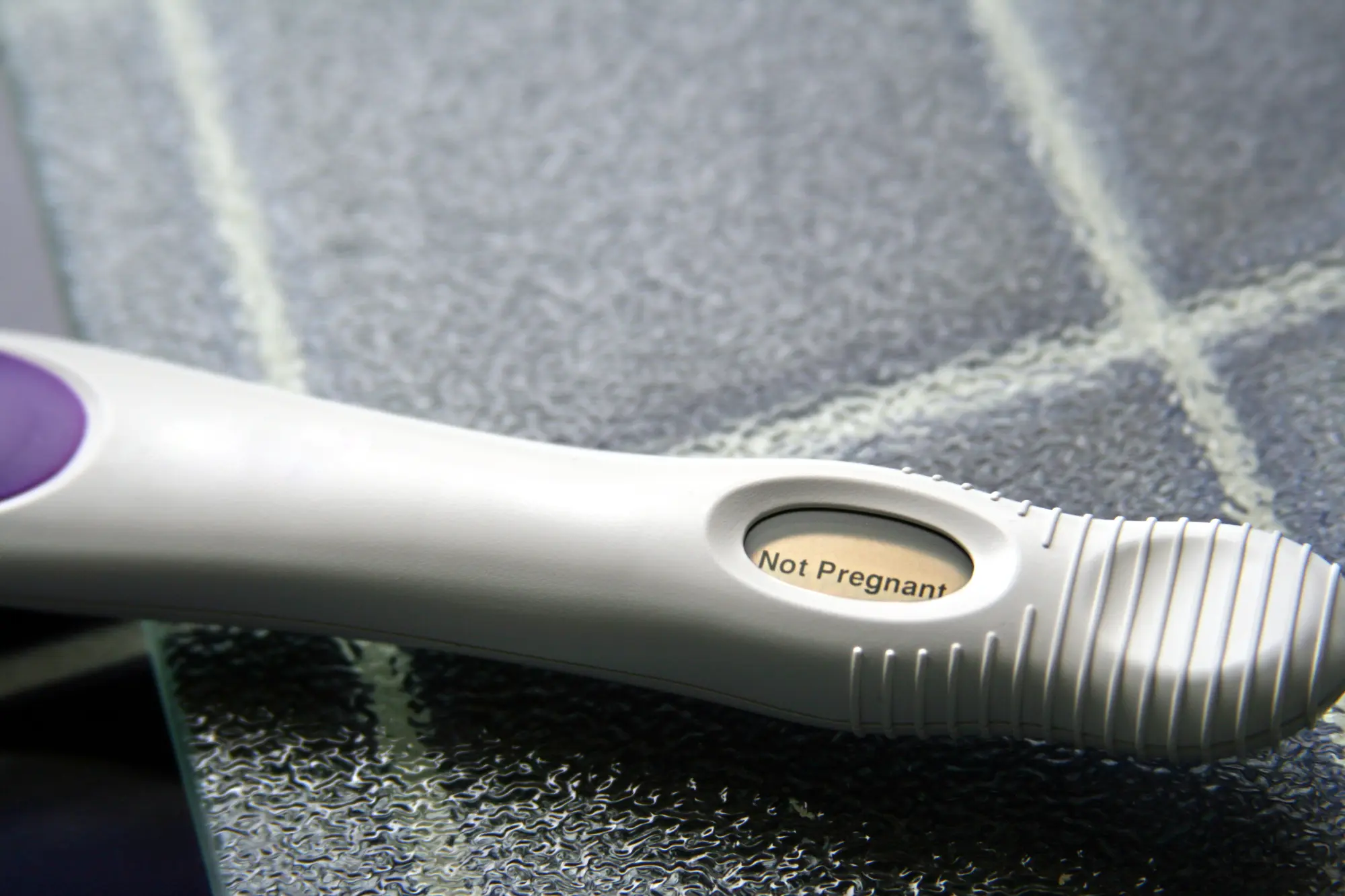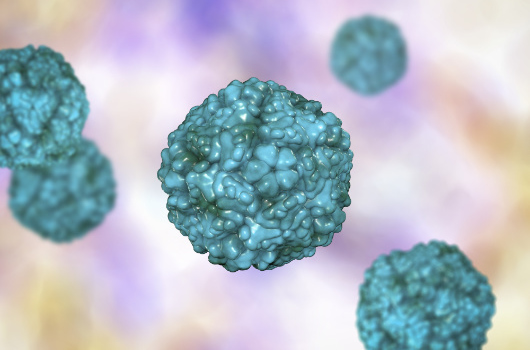Clinical Study
STIs and Infertility: Role of Early Detection Through Molecular Testing

Dr. Pallavi Upadhyay • May 19, 2025
Silent and often undetected, sexually transmitted infections (STIs) are a major underlying factor of infertility, posing a serious threat to reproductive health globally. The article underscores a critical but underrecognized connection between STIs and fertility challenges. With millions of new cases each year and many going unnoticed, early and accurate STI screening is becoming increasingly critical, especially as advanced molecular testing platforms pave the way for improved reproductive outcomes, enabling targeted treatment and fertility preservation.
Burden of Infertility
Infertility is a medical condition that is defined by the inability to conceive or get pregnant despite a year or more of regular, timed and unprotected sexual intercourse1. According to the World Health Organization, 1 in 6 individuals worldwide deal with infertility issues in their lifetime1. According to published reports, in the United States, 12-15% of couples are unable to get pregnant after a year of unprotected sexual intercourse.
Infertility can lead to not only medical/healthcare burden but also economic, social and psychological burden. Social stigma attached to infertility can have severe psychological impacts such as anxiety, low self-esteem, the stigma of childlessness, etc. These impacts are more severe in countries where childbirth is associated with secure marriage and property inheritance2,3.
Causes of Infertility
Several factors, associated with male or female reproductive system, can lead to infertility.
In females, the infertility can result from4,5,6,7:
- Tubal factor infertility (TFI)
- Uterine disorders
- Ovarian disorders
- Imbalances of reproductive hormones
In males, the infertility can result from6,8:
- Dysfunctional reproductive tract
- Imbalances of reproductive hormones
- Failure of testicular sperm production
Impact of STIs in infertility
According to a study, 20 million new sexually transmitted infections (STIs) each year in the United States, half of cases occur among the age group of 15–24 years9. CDC reported 2.4 million STIs in the year 202310. STIs are often asymptomatic and thus despite being highly transmissible, are often undetected and undiagnosed11. However, they have a long-lasting impact on sexual health—especially on the ability to reproduce offsprings12,13. Untreated syphilis, chlamydia and gonococcal infections are among the leading preventable causes of infertility worldwide14.
These common STIs, when left untreated, can lead to inflammation and scarring in reproductive organs, which in turn can result in dysfunctional or damaged reproductive organs.
Chlamydia and Gonorrhea
Chlamydia trachomatis, a gram-negative bacteria, is the leading cause of STI worldwide. Study shows that C. trachomatis impacts more than 1.5 million Americans each year15. The second most common STI that impacts fertility is gonorrhea (causative agent Neisseria gonorrhoeae, a gram-negative bacteria)14. Noteworthy, both C. trachomatis and. N gonorrhoeae infections are asymptomatic and can remain unnoticed and untreated for a long period of time. These untreated infections impact genital tract (ascending from cervix) and can cause inflammation and damage to the fallopian tube, leading in salpingitis and further in pelvic inflammatory disease (PID)16,17,18. PIDs are strongly associated in causing TFI or exacerbating pre-existing TFI conditions. In fact, studies have shown that PID occurrence in a female is directly correlated to risk of infertility18,19. These chlamydial and gonococcal infections in females, can also lead to ectopic pregnancy and increase the risk of birth complications in newborns (e.g. premature birth, underweight infants, ocular and lung infections, etc.)20.
Some other important STIs that impact fertility are: Mycoplasma genitalium, Trichomonas vaginalis, Syphilis, Human Papillomavirus (HPV), Herpes Simplex Virus (HSV), and HIV.
According to reports, in the United States, detection rate of M. genitalium infections are approximately 15-20% in high-risk, sexually active females and is also known to cause TFI. In males, it is associated with urethritis21.
T. vaginalis accounts for approximately half of the global incidence of curable STIs worldwide. Despite the economic and healthcare burden T. vaginalis on reproductive tract is relatively under-researched. There are studies that provide evidence of the role of T. vaginalis in causing pelvic inflammation and its association with endometriosis and PIDs22.
Noteworthy, co-infections of one or more of above-mentioned STI-causing pathogens increase the risk of genital tract infections as well as exacerbate any existing STI23. Coinfections can also impair efficacy of treatment and preventative measures23.
Ureaplasmas (e.g., U. urealyticum), can also contribute to female infertility24. In fact, female infertility can be affected by variations in vaginal microbial flora. A metanalysis published shows a direct correlation between infertility and bacterial vaginosis25.
Role of STI Diagnosis in Preventing Infertility
Common STIs such as chlamydia and gonorrhea, are often asymptomatic, and therefore the infected individuals may not depict clinical symptoms until the infection has progressed. Early detection through testing allows for:
- Prevent transmission: Awareness of STI status is crucial to be able to make informed decisions regarding their sexual health and preventive measures. Early detection is also critical to prevent the transmission to others.
- Reduce Risk of Complications: untreated STIs can lead to PIDs, infertility and increase the risk of certain cancers. Therefore, early detection is paramount to stay ahead of STIs.
- Prompt Treatment: Early detections enable the practitioner to initiate timely antimicrobial therapy for microbial STIs and management of viral STIs.
Routine STI Screening is recommended for sexually active individuals, high-risk individuals (individuals with multiple partners, with history of STIs, and other risk factors). CDC recommends screening for STI for sexually active individuals26.
STI Diagnosis: Role of Molecular PCR Tests
Some commonly used lab Techniques to detect STIs are as follows:
- Antigen Tests
- Serology tests
- Microscopy tests
- Microbial culture tests
- Molecular PCR tests
Lower sensitivity and specificity are the main challenges associated with antigen and serology tests to detect STIs. Whereas traditional methods like culture and microscopy are often not preferred due to low sensitivity as well as delayed turnaround time. Molecular PCR tests are emerging as “gold standard” for clinical testing of STIs. Owing to their high sensitivity and specificity, molecular PCR tests can diagnose the STIs, even at low concentrations (especially during asymptomatic phases of the pathogen life cycle) facilitating early diagnosis and treatments27,28.
Multiplex PCR is gaining more popularity as a critical diagnostic tool for STI testing as it allows for early detection of several pathogens simultaneously in a single test within hours. PCR’s faster turnaround time as compared to traditional method also adds to the reason for popularity.
Conclusion
Social stigma and lack of awareness associated with STIs remain most significant barriers to STI testing. Making diagnostic tests more accessible and available to individuals, especially those in resource-limited settings, can improve testing rates and thus the treatment outcomes.
Prompt and accurate diagnosis is not only essential for timely clinical interventions but also for the prevention of long-term reproductive complications, thereby improving fertility treatment outcomes (e.g., IVF or IUI). Incorporating PCR-based STI screening in fertility clinics enables practitioners to diagnose and treat any infections preceding the targeted fertility treatments, enhancing the attempts of a successful conception and minimizing the risk of transmission or complications.
Future studies to evaluate the direct impact of STI screening/testing for common STIs on the infertility rate within the population can help guide clinical practice and healthcare policies in reducing the global burden of infertility.
References
- WHO. 1 in 6 people globally affected by infertility. https://www.who.int/news/item/04-04-2023-1-in-6-people-globally-affected-by-infertility. Accessed 5-7-25.
- The Lancet Global Health. Infertility—why the silence? *Lancet Glob Health*. 2022 Jun;10(6):e773.
- Ezeh A, Bankole A, Cleland J, García-Moreno C, Temmerman M, Ziraba AK. Burden of Reproductive Ill Health. *Reproductive, Maternal, Newborn, and Child Health: Disease Control Priorities*. 2016;11:25.
- Walker MH, Tobler KJ. Female Infertility. [Updated 2022 Dec 19]. In: *StatPearls* [Internet]. Treasure Island (FL): StatPearls Publishing; 2025 Jan–. Available from: https://www.ncbi.nlm.nih.gov/books/NBK556033/
- Ambildhuke K, Pajai S, Chimegave A, Mundhada R, Kabra P. A Review of Tubal Factors Affecting Fertility and its Management. *Cureus*. 2022 Nov 1;14(11):e30990.
- WHO. Infertility. https://www.who.int/news-room/fact-sheets/detail/infertility. Accessed 5-7-25.
- CDC. Infertility. https://www.cdc.gov/nchs/fastats/infertility.htm. Accessed 5-7-25.
- Leslie SW, Soon-Sutton TL, Khan MAB. Male Infertility. [Updated 2024 Feb 25]. In: *StatPearls* [Internet]. Treasure Island (FL): StatPearls Publishing; 2025 Jan. Available from: https://www.ncbi.nlm.nih.gov/books/NBK562258/
- Shannon CL, Klausner JD. The growing epidemic of sexually transmitted infections in adolescents: a neglected population. *Curr Opin Pediatr*. 2018;30(1):137-143.
- CDC. Sexually Transmitted Infections Surveillance, 2023. https://www.cdc.gov/sti-statistics/annual/index.html. Accessed 5-7-25.
- Kenyon C, Herrmann B, Hughes G, de Vries HJC. Management of asymptomatic sexually transmitted infections in Europe: towards a differentiated, evidence-based approach. *Lancet Reg Health Eur*. 2023 Oct 26;34:100743.
- Harville EW, Kruse AN, Zhao Q. The Impact of Early-Life Exposures on Women’s Reproductive Health in Adulthood. *Curr Epidemiol Rep*. 2021;8(4):175-189.
- Apari P, de Sousa JD, Müller V. Why sexually transmitted infections tend to cause infertility: an evolutionary hypothesis. *PLoS Pathog*. 2014 Aug 7;10(8):e1004111.
- Tsevat DG, Wiesenfeld HC, Parks C, Peipert JF. Sexually transmitted diseases and infertility. *Am J Obstet Gynecol*. 2017 Jan;216(1):1-9.
- Chambers LC, Khosropour CM, Katz DA, Dombrowski JC, Manhart LE, Golden MR. Racial/Ethnic Disparities in the Lifetime Risk of Chlamydia trachomatis Diagnosis and Adverse Reproductive Health Outcomes Among Women in King County, Washington. Clin Infect Dis. 2018 Aug 1;67(4):593–599.
- Quaas A, Dokras A. Diagnosis and Treatment of Unexplained Infertility. Rev Obstet Gynecol. 2008;1(2):69–76.
- Wiesenfeld HC, Cates W Jr. Sexually Transmitted Diseases and Infertility. In: Holmes KK, Sparling PF, Stamm WE, Piot P, Wasserheit JN, Corey L, Cohen MS, Watts DH, editors. Sexually Transmitted Diseases. Vol. 4. McGraw Hill; 2008. pp. 1511–29.
- Ross JDC. Pelvic inflammatory disease. Medicine. 2014;42(6):333–337.
- Westrom L. Effect of pelvic inflammatory disease on fertility. Venereology. 1995;8(4):219–222.
- Cantor A, Dana T, Griffin JC, et al. Screening for Chlamydial and Gonococcal Infections: A Systematic Review Update for the U.S. Preventive Services Task Force [Internet]. Rockville (MD): Agency for Healthcare Research and Quality (US); 2021 Sep. (Evidence Synthesis, No. 206.) Chapter 1, Introduction and Background. Available from: https://www.ncbi.nlm.nih.gov/books/NBK574047/
- Ona S, Molina RL, Diouf K. Mycoplasma genitalium: An Overlooked Sexually Transmitted Pathogen in Women? Infect Dis Obstet Gynecol. 2016;2016:4513089.
- Kissinger P. Epidemiology and treatment of trichomoniasis. Curr Infect Dis Rep. 2015;17(6):484.
- Ghasemian E, Harding-Esch E, Mabey D, Holland MJ. When Bacteria and Viruses Collide: A Tale of Chlamydia trachomatis and Sexually Transmitted Viruses. Viruses. 2023;15(9):1954.
- Farzand JK, Rahman R. Prevalence of Mycoplasma hominis and Ureaplasma urealyticum among women with unexplained infertility, with and without vaginitis and cervicitis. Afr J Microbiol Res. 2011;5(8):861–864.
- van Oostrum N, De Sutter P, Meys J, Verstraelen H. Risks associated with bacterial vaginosis in infertility patients: a systematic review and meta-analysis. Hum Reprod. 2013:det096.
- CDC. Getting Tested for STIs. https://www.cdc.gov/sti/testing/index.html. Accessed 5-7-25.
- Naeem F, Karellis A, Nair S, Routy JP, Yansouni CP, Kim J, Pai N. Multiplexed technologies for sexually transmitted infections: global evidence on patient-centered and clinical health outcomes. BMJ Glob Health. 2021 Jul;6(7):e005670.
- Karellis A, Naeem F, Mallya SD. Evaluation of rapid multiplex diagnostic devices for sexually-transmitted infections: a systematic review. Prospero 2020 CRD42020179218.
References
- WHO. 1 in 6 people globally affected by infertility. https://www.who.int/news/item/04-04-2023-1-in-6-people-globally-affected-by-infertility. Accessed 5-7-25.
- The Lancet Global Health. Infertility—why the silence? *Lancet Glob Health*. 2022 Jun;10(6):e773.
- Ezeh A, Bankole A, Cleland J, García-Moreno C, Temmerman M, Ziraba AK. Burden of Reproductive Ill Health. *Reproductive, Maternal, Newborn, and Child Health: Disease Control Priorities*. 2016;11:25.
- Walker MH, Tobler KJ. Female Infertility. [Updated 2022 Dec 19]. In: *StatPearls* [Internet]. Treasure Island (FL): StatPearls Publishing; 2025 Jan–. Available from: https://www.ncbi.nlm.nih.gov/books/NBK556033/
- Ambildhuke K, Pajai S, Chimegave A, Mundhada R, Kabra P. A Review of Tubal Factors Affecting Fertility and its Management. *Cureus*. 2022 Nov 1;14(11):e30990.
- WHO. Infertility. https://www.who.int/news-room/fact-sheets/detail/infertility. Accessed 5-7-25.
- CDC. Infertility. https://www.cdc.gov/nchs/fastats/infertility.htm. Accessed 5-7-25.
- Leslie SW, Soon-Sutton TL, Khan MAB. Male Infertility. [Updated 2024 Feb 25]. In: *StatPearls* [Internet]. Treasure Island (FL): StatPearls Publishing; 2025 Jan. Available from: https://www.ncbi.nlm.nih.gov/books/NBK562258/
- Shannon CL, Klausner JD. The growing epidemic of sexually transmitted infections in adolescents: a neglected population. *Curr Opin Pediatr*. 2018;30(1):137-143.
- CDC. Sexually Transmitted Infections Surveillance, 2023. https://www.cdc.gov/sti-statistics/annual/index.html. Accessed 5-7-25.
- Kenyon C, Herrmann B, Hughes G, de Vries HJC. Management of asymptomatic sexually transmitted infections in Europe: towards a differentiated, evidence-based approach. *Lancet Reg Health Eur*. 2023 Oct 26;34:100743.
- Harville EW, Kruse AN, Zhao Q. The Impact of Early-Life Exposures on Women’s Reproductive Health in Adulthood. *Curr Epidemiol Rep*. 2021;8(4):175-189.
- Apari P, de Sousa JD, Müller V. Why sexually transmitted infections tend to cause infertility: an evolutionary hypothesis. *PLoS Pathog*. 2014 Aug 7;10(8):e1004111.
- Tsevat DG, Wiesenfeld HC, Parks C, Peipert JF. Sexually transmitted diseases and infertility. *Am J Obstet Gynecol*. 2017 Jan;216(1):1-9.
- Chambers LC, Khosropour CM, Katz DA, Dombrowski JC, Manhart LE, Golden MR. Racial/Ethnic Disparities in the Lifetime Risk of Chlamydia trachomatis Diagnosis and Adverse Reproductive Health Outcomes Among Women in King County, Washington. Clin Infect Dis. 2018 Aug 1;67(4):593–599.
- Quaas A, Dokras A. Diagnosis and Treatment of Unexplained Infertility. Rev Obstet Gynecol. 2008;1(2):69–76.
- Wiesenfeld HC, Cates W Jr. Sexually Transmitted Diseases and Infertility. In: Holmes KK, Sparling PF, Stamm WE, Piot P, Wasserheit JN, Corey L, Cohen MS, Watts DH, editors. Sexually Transmitted Diseases. Vol. 4. McGraw Hill; 2008. pp. 1511–29.
- Ross JDC. Pelvic inflammatory disease. Medicine. 2014;42(6):333–337.
- Westrom L. Effect of pelvic inflammatory disease on fertility. Venereology. 1995;8(4):219–222.
- Cantor A, Dana T, Griffin JC, et al. Screening for Chlamydial and Gonococcal Infections: A Systematic Review Update for the U.S. Preventive Services Task Force [Internet]. Rockville (MD): Agency for Healthcare Research and Quality (US); 2021 Sep. (Evidence Synthesis, No. 206.) Chapter 1, Introduction and Background. Available from: https://www.ncbi.nlm.nih.gov/books/NBK574047/
- Ona S, Molina RL, Diouf K. Mycoplasma genitalium: An Overlooked Sexually Transmitted Pathogen in Women? Infect Dis Obstet Gynecol. 2016;2016:4513089.
- Kissinger P. Epidemiology and treatment of trichomoniasis. Curr Infect Dis Rep. 2015;17(6):484.
- Ghasemian E, Harding-Esch E, Mabey D, Holland MJ. When Bacteria and Viruses Collide: A Tale of Chlamydia trachomatis and Sexually Transmitted Viruses. Viruses. 2023;15(9):1954.
- Farzand JK, Rahman R. Prevalence of Mycoplasma hominis and Ureaplasma urealyticum among women with unexplained infertility, with and without vaginitis and cervicitis. Afr J Microbiol Res. 2011;5(8):861–864.
- van Oostrum N, De Sutter P, Meys J, Verstraelen H. Risks associated with bacterial vaginosis in infertility patients: a systematic review and meta-analysis. Hum Reprod. 2013:det096.
- CDC. Getting Tested for STIs. https://www.cdc.gov/sti/testing/index.html. Accessed 5-7-25.
- Naeem F, Karellis A, Nair S, Routy JP, Yansouni CP, Kim J, Pai N. Multiplexed technologies for sexually transmitted infections: global evidence on patient-centered and clinical health outcomes. BMJ Glob Health. 2021 Jul;6(7):e005670.
- Karellis A, Naeem F, Mallya SD. Evaluation of rapid multiplex diagnostic devices for sexually-transmitted infections: a systematic review. Prospero 2020 CRD42020179218.
Related Articles and White papers

Dr. Pallavi Upadhyay • May 19, 2025
Silent and often undetected, sexually transmitted infections (STIs) are a major underlying factor of infertility, posing a serious threat to reproductive health globally. The article underscores a critical but underrecognized connection between STIs and fertility challenges. With millions of new cases each year and many going unnoticed, early and accurate STI screening is becoming increasingly critical, especially as advanced molecular testing platforms pave the way for improved reproductive outcomes, enabling targeted treatment and fertility preservation.
Burden of Infertility
Infertility is a medical condition that is defined by the inability to conceive or get pregnant despite a year or more of regular, timed and unprotected sexual intercourse1. According to the World Health Organization, 1 in 6 individuals worldwide deal with infertility issues in their lifetime1. According to published reports, in the United States, 12-15% of couples are unable to get pregnant after a year of unprotected sexual intercourse.
Infertility can lead to not only medical/healthcare burden but also economic, social and psychological burden. Social stigma attached to infertility can have severe psychological impacts such as anxiety, low self-esteem, the stigma of childlessness, etc. These impacts are more severe in countries where childbirth is associated with secure marriage and property inheritance2,3.
Causes of Infertility
Several factors, associated with male or female reproductive system, can lead to infertility.
In females, the infertility can result from4,5,6,7:
- Tubal factor infertility (TFI)
- Uterine disorders
- Ovarian disorders
- Imbalances of reproductive hormones
In males, the infertility can result from6,8:
- Dysfunctional reproductive tract
- Imbalances of reproductive hormones
- Failure of testicular sperm production
Impact of STIs in infertility
According to a study, 20 million new sexually transmitted infections (STIs) each year in the United States, half of cases occur among the age group of 15–24 years9. CDC reported 2.4 million STIs in the year 202310. STIs are often asymptomatic and thus despite being highly transmissible, are often undetected and undiagnosed11. However, they have a long-lasting impact on sexual health—especially on the ability to reproduce offsprings12,13. Untreated syphilis, chlamydia and gonococcal infections are among the leading preventable causes of infertility worldwide14.
These common STIs, when left untreated, can lead to inflammation and scarring in reproductive organs, which in turn can result in dysfunctional or damaged reproductive organs.
Chlamydia and Gonorrhea
Chlamydia trachomatis, a gram-negative bacteria, is the leading cause of STI worldwide. Study shows that C. trachomatis impacts more than 1.5 million Americans each year15. The second most common STI that impacts fertility is gonorrhea (causative agent Neisseria gonorrhoeae, a gram-negative bacteria)14. Noteworthy, both C. trachomatis and. N gonorrhoeae infections are asymptomatic and can remain unnoticed and untreated for a long period of time. These untreated infections impact genital tract (ascending from cervix) and can cause inflammation and damage to the fallopian tube, leading in salpingitis and further in pelvic inflammatory disease (PID)16,17,18. PIDs are strongly associated in causing TFI or exacerbating pre-existing TFI conditions. In fact, studies have shown that PID occurrence in a female is directly correlated to risk of infertility18,19. These chlamydial and gonococcal infections in females, can also lead to ectopic pregnancy and increase the risk of birth complications in newborns (e.g. premature birth, underweight infants, ocular and lung infections, etc.)20.
Some other important STIs that impact fertility are: Mycoplasma genitalium, Trichomonas vaginalis, Syphilis, Human Papillomavirus (HPV), Herpes Simplex Virus (HSV), and HIV.
According to reports, in the United States, detection rate of M. genitalium infections are approximately 15-20% in high-risk, sexually active females and is also known to cause TFI. In males, it is associated with urethritis21.
T. vaginalis accounts for approximately half of the global incidence of curable STIs worldwide. Despite the economic and healthcare burden T. vaginalis on reproductive tract is relatively under-researched. There are studies that provide evidence of the role of T. vaginalis in causing pelvic inflammation and its association with endometriosis and PIDs22.
Noteworthy, co-infections of one or more of above-mentioned STI-causing pathogens increase the risk of genital tract infections as well as exacerbate any existing STI23. Coinfections can also impair efficacy of treatment and preventative measures23.
Ureaplasmas (e.g., U. urealyticum), can also contribute to female infertility24. In fact, female infertility can be affected by variations in vaginal microbial flora. A metanalysis published shows a direct correlation between infertility and bacterial vaginosis25.
Role of STI Diagnosis in Preventing Infertility
Common STIs such as chlamydia and gonorrhea, are often asymptomatic, and therefore the infected individuals may not depict clinical symptoms until the infection has progressed. Early detection through testing allows for:
- Prevent transmission: Awareness of STI status is crucial to be able to make informed decisions regarding their sexual health and preventive measures. Early detection is also critical to prevent the transmission to others.
- Reduce Risk of Complications: untreated STIs can lead to PIDs, infertility and increase the risk of certain cancers. Therefore, early detection is paramount to stay ahead of STIs.
- Prompt Treatment: Early detections enable the practitioner to initiate timely antimicrobial therapy for microbial STIs and management of viral STIs.
Routine STI Screening is recommended for sexually active individuals, high-risk individuals (individuals with multiple partners, with history of STIs, and other risk factors). CDC recommends screening for STI for sexually active individuals26.
STI Diagnosis: Role of Molecular PCR Tests
Some commonly used lab Techniques to detect STIs are as follows:
- Antigen Tests
- Serology tests
- Microscopy tests
- Microbial culture tests
- Molecular PCR tests
Lower sensitivity and specificity are the main challenges associated with antigen and serology tests to detect STIs. Whereas traditional methods like culture and microscopy are often not preferred due to low sensitivity as well as delayed turnaround time. Molecular PCR tests are emerging as “gold standard” for clinical testing of STIs. Owing to their high sensitivity and specificity, molecular PCR tests can diagnose the STIs, even at low concentrations (especially during asymptomatic phases of the pathogen life cycle) facilitating early diagnosis and treatments27,28.
Multiplex PCR is gaining more popularity as a critical diagnostic tool for STI testing as it allows for early detection of several pathogens simultaneously in a single test within hours. PCR’s faster turnaround time as compared to traditional method also adds to the reason for popularity.
Conclusion
Social stigma and lack of awareness associated with STIs remain most significant barriers to STI testing. Making diagnostic tests more accessible and available to individuals, especially those in resource-limited settings, can improve testing rates and thus the treatment outcomes.
Prompt and accurate diagnosis is not only essential for timely clinical interventions but also for the prevention of long-term reproductive complications, thereby improving fertility treatment outcomes (e.g., IVF or IUI). Incorporating PCR-based STI screening in fertility clinics enables practitioners to diagnose and treat any infections preceding the targeted fertility treatments, enhancing the attempts of a successful conception and minimizing the risk of transmission or complications.
Future studies to evaluate the direct impact of STI screening/testing for common STIs on the infertility rate within the population can help guide clinical practice and healthcare policies in reducing the global burden of infertility.
References
- WHO. 1 in 6 people globally affected by infertility. https://www.who.int/news/item/04-04-2023-1-in-6-people-globally-affected-by-infertility. Accessed 5-7-25.
- The Lancet Global Health. Infertility—why the silence? *Lancet Glob Health*. 2022 Jun;10(6):e773.
- Ezeh A, Bankole A, Cleland J, García-Moreno C, Temmerman M, Ziraba AK. Burden of Reproductive Ill Health. *Reproductive, Maternal, Newborn, and Child Health: Disease Control Priorities*. 2016;11:25.
- Walker MH, Tobler KJ. Female Infertility. [Updated 2022 Dec 19]. In: *StatPearls* [Internet]. Treasure Island (FL): StatPearls Publishing; 2025 Jan–. Available from: https://www.ncbi.nlm.nih.gov/books/NBK556033/
- Ambildhuke K, Pajai S, Chimegave A, Mundhada R, Kabra P. A Review of Tubal Factors Affecting Fertility and its Management. *Cureus*. 2022 Nov 1;14(11):e30990.
- WHO. Infertility. https://www.who.int/news-room/fact-sheets/detail/infertility. Accessed 5-7-25.
- CDC. Infertility. https://www.cdc.gov/nchs/fastats/infertility.htm. Accessed 5-7-25.
- Leslie SW, Soon-Sutton TL, Khan MAB. Male Infertility. [Updated 2024 Feb 25]. In: *StatPearls* [Internet]. Treasure Island (FL): StatPearls Publishing; 2025 Jan. Available from: https://www.ncbi.nlm.nih.gov/books/NBK562258/
- Shannon CL, Klausner JD. The growing epidemic of sexually transmitted infections in adolescents: a neglected population. *Curr Opin Pediatr*. 2018;30(1):137-143.
- CDC. Sexually Transmitted Infections Surveillance, 2023. https://www.cdc.gov/sti-statistics/annual/index.html. Accessed 5-7-25.
- Kenyon C, Herrmann B, Hughes G, de Vries HJC. Management of asymptomatic sexually transmitted infections in Europe: towards a differentiated, evidence-based approach. *Lancet Reg Health Eur*. 2023 Oct 26;34:100743.
- Harville EW, Kruse AN, Zhao Q. The Impact of Early-Life Exposures on Women’s Reproductive Health in Adulthood. *Curr Epidemiol Rep*. 2021;8(4):175-189.
- Apari P, de Sousa JD, Müller V. Why sexually transmitted infections tend to cause infertility: an evolutionary hypothesis. *PLoS Pathog*. 2014 Aug 7;10(8):e1004111.
- Tsevat DG, Wiesenfeld HC, Parks C, Peipert JF. Sexually transmitted diseases and infertility. *Am J Obstet Gynecol*. 2017 Jan;216(1):1-9.
- Chambers LC, Khosropour CM, Katz DA, Dombrowski JC, Manhart LE, Golden MR. Racial/Ethnic Disparities in the Lifetime Risk of Chlamydia trachomatis Diagnosis and Adverse Reproductive Health Outcomes Among Women in King County, Washington. Clin Infect Dis. 2018 Aug 1;67(4):593–599.
- Quaas A, Dokras A. Diagnosis and Treatment of Unexplained Infertility. Rev Obstet Gynecol. 2008;1(2):69–76.
- Wiesenfeld HC, Cates W Jr. Sexually Transmitted Diseases and Infertility. In: Holmes KK, Sparling PF, Stamm WE, Piot P, Wasserheit JN, Corey L, Cohen MS, Watts DH, editors. Sexually Transmitted Diseases. Vol. 4. McGraw Hill; 2008. pp. 1511–29.
- Ross JDC. Pelvic inflammatory disease. Medicine. 2014;42(6):333–337.
- Westrom L. Effect of pelvic inflammatory disease on fertility. Venereology. 1995;8(4):219–222.
- Cantor A, Dana T, Griffin JC, et al. Screening for Chlamydial and Gonococcal Infections: A Systematic Review Update for the U.S. Preventive Services Task Force [Internet]. Rockville (MD): Agency for Healthcare Research and Quality (US); 2021 Sep. (Evidence Synthesis, No. 206.) Chapter 1, Introduction and Background. Available from: https://www.ncbi.nlm.nih.gov/books/NBK574047/
- Ona S, Molina RL, Diouf K. Mycoplasma genitalium: An Overlooked Sexually Transmitted Pathogen in Women? Infect Dis Obstet Gynecol. 2016;2016:4513089.
- Kissinger P. Epidemiology and treatment of trichomoniasis. Curr Infect Dis Rep. 2015;17(6):484.
- Ghasemian E, Harding-Esch E, Mabey D, Holland MJ. When Bacteria and Viruses Collide: A Tale of Chlamydia trachomatis and Sexually Transmitted Viruses. Viruses. 2023;15(9):1954.
- Farzand JK, Rahman R. Prevalence of Mycoplasma hominis and Ureaplasma urealyticum among women with unexplained infertility, with and without vaginitis and cervicitis. Afr J Microbiol Res. 2011;5(8):861–864.
- van Oostrum N, De Sutter P, Meys J, Verstraelen H. Risks associated with bacterial vaginosis in infertility patients: a systematic review and meta-analysis. Hum Reprod. 2013:det096.
- CDC. Getting Tested for STIs. https://www.cdc.gov/sti/testing/index.html. Accessed 5-7-25.
- Naeem F, Karellis A, Nair S, Routy JP, Yansouni CP, Kim J, Pai N. Multiplexed technologies for sexually transmitted infections: global evidence on patient-centered and clinical health outcomes. BMJ Glob Health. 2021 Jul;6(7):e005670.
- Karellis A, Naeem F, Mallya SD. Evaluation of rapid multiplex diagnostic devices for sexually-transmitted infections: a systematic review. Prospero 2020 CRD42020179218.
References
- WHO. 1 in 6 people globally affected by infertility. https://www.who.int/news/item/04-04-2023-1-in-6-people-globally-affected-by-infertility. Accessed 5-7-25.
- The Lancet Global Health. Infertility—why the silence? *Lancet Glob Health*. 2022 Jun;10(6):e773.
- Ezeh A, Bankole A, Cleland J, García-Moreno C, Temmerman M, Ziraba AK. Burden of Reproductive Ill Health. *Reproductive, Maternal, Newborn, and Child Health: Disease Control Priorities*. 2016;11:25.
- Walker MH, Tobler KJ. Female Infertility. [Updated 2022 Dec 19]. In: *StatPearls* [Internet]. Treasure Island (FL): StatPearls Publishing; 2025 Jan–. Available from: https://www.ncbi.nlm.nih.gov/books/NBK556033/
- Ambildhuke K, Pajai S, Chimegave A, Mundhada R, Kabra P. A Review of Tubal Factors Affecting Fertility and its Management. *Cureus*. 2022 Nov 1;14(11):e30990.
- WHO. Infertility. https://www.who.int/news-room/fact-sheets/detail/infertility. Accessed 5-7-25.
- CDC. Infertility. https://www.cdc.gov/nchs/fastats/infertility.htm. Accessed 5-7-25.
- Leslie SW, Soon-Sutton TL, Khan MAB. Male Infertility. [Updated 2024 Feb 25]. In: *StatPearls* [Internet]. Treasure Island (FL): StatPearls Publishing; 2025 Jan. Available from: https://www.ncbi.nlm.nih.gov/books/NBK562258/
- Shannon CL, Klausner JD. The growing epidemic of sexually transmitted infections in adolescents: a neglected population. *Curr Opin Pediatr*. 2018;30(1):137-143.
- CDC. Sexually Transmitted Infections Surveillance, 2023. https://www.cdc.gov/sti-statistics/annual/index.html. Accessed 5-7-25.
- Kenyon C, Herrmann B, Hughes G, de Vries HJC. Management of asymptomatic sexually transmitted infections in Europe: towards a differentiated, evidence-based approach. *Lancet Reg Health Eur*. 2023 Oct 26;34:100743.
- Harville EW, Kruse AN, Zhao Q. The Impact of Early-Life Exposures on Women’s Reproductive Health in Adulthood. *Curr Epidemiol Rep*. 2021;8(4):175-189.
- Apari P, de Sousa JD, Müller V. Why sexually transmitted infections tend to cause infertility: an evolutionary hypothesis. *PLoS Pathog*. 2014 Aug 7;10(8):e1004111.
- Tsevat DG, Wiesenfeld HC, Parks C, Peipert JF. Sexually transmitted diseases and infertility. *Am J Obstet Gynecol*. 2017 Jan;216(1):1-9.
- Chambers LC, Khosropour CM, Katz DA, Dombrowski JC, Manhart LE, Golden MR. Racial/Ethnic Disparities in the Lifetime Risk of Chlamydia trachomatis Diagnosis and Adverse Reproductive Health Outcomes Among Women in King County, Washington. Clin Infect Dis. 2018 Aug 1;67(4):593–599.
- Quaas A, Dokras A. Diagnosis and Treatment of Unexplained Infertility. Rev Obstet Gynecol. 2008;1(2):69–76.
- Wiesenfeld HC, Cates W Jr. Sexually Transmitted Diseases and Infertility. In: Holmes KK, Sparling PF, Stamm WE, Piot P, Wasserheit JN, Corey L, Cohen MS, Watts DH, editors. Sexually Transmitted Diseases. Vol. 4. McGraw Hill; 2008. pp. 1511–29.
- Ross JDC. Pelvic inflammatory disease. Medicine. 2014;42(6):333–337.
- Westrom L. Effect of pelvic inflammatory disease on fertility. Venereology. 1995;8(4):219–222.
- Cantor A, Dana T, Griffin JC, et al. Screening for Chlamydial and Gonococcal Infections: A Systematic Review Update for the U.S. Preventive Services Task Force [Internet]. Rockville (MD): Agency for Healthcare Research and Quality (US); 2021 Sep. (Evidence Synthesis, No. 206.) Chapter 1, Introduction and Background. Available from: https://www.ncbi.nlm.nih.gov/books/NBK574047/
- Ona S, Molina RL, Diouf K. Mycoplasma genitalium: An Overlooked Sexually Transmitted Pathogen in Women? Infect Dis Obstet Gynecol. 2016;2016:4513089.
- Kissinger P. Epidemiology and treatment of trichomoniasis. Curr Infect Dis Rep. 2015;17(6):484.
- Ghasemian E, Harding-Esch E, Mabey D, Holland MJ. When Bacteria and Viruses Collide: A Tale of Chlamydia trachomatis and Sexually Transmitted Viruses. Viruses. 2023;15(9):1954.
- Farzand JK, Rahman R. Prevalence of Mycoplasma hominis and Ureaplasma urealyticum among women with unexplained infertility, with and without vaginitis and cervicitis. Afr J Microbiol Res. 2011;5(8):861–864.
- van Oostrum N, De Sutter P, Meys J, Verstraelen H. Risks associated with bacterial vaginosis in infertility patients: a systematic review and meta-analysis. Hum Reprod. 2013:det096.
- CDC. Getting Tested for STIs. https://www.cdc.gov/sti/testing/index.html. Accessed 5-7-25.
- Naeem F, Karellis A, Nair S, Routy JP, Yansouni CP, Kim J, Pai N. Multiplexed technologies for sexually transmitted infections: global evidence on patient-centered and clinical health outcomes. BMJ Glob Health. 2021 Jul;6(7):e005670.
- Karellis A, Naeem F, Mallya SD. Evaluation of rapid multiplex diagnostic devices for sexually-transmitted infections: a systematic review. Prospero 2020 CRD42020179218.




